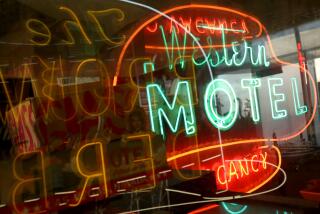Neon!The beginning of the 20th Century found...
- Share via
Neon!
The beginning of the 20th Century found Frenchman Georges Claude looking for a quick and inexpensive way to produce oxygen for use in hospitals and welding torches. Instead, Claude stumbled upon a method for producing large quantities of rare gases such as neon and argon. When these gases were injected into glass tubes and then zapped with a current of electricity, they produced bright orange and blue light.
Claude, who exhibited a neon gas sign in Paris in 1910, thought neon could compete against Edison’s light bulb as a source of indoor and outdoor light, according to the book “Let There Be Neon” by Rudi Stern. Instead, neon became used as a form of commercial advertising. The first neon sign was installed in a Parisian barbershop in 1912.
In 1923, the first permanent neon signs to shine in America were installed in the windows of a Los Angeles Packard dealership on Wilshire Boulevard. Purchased for $1,250 from the Claude Neon factory in Paris, the pair of signs featured the word Packard in red and a blue border. The signs were so effective at drawing attention that they caused another 20th-Century phenomenon: the traffic jam.
Some of those traffic-stopping neon signs along Melrose Avenue may not really be neon. Neon is the generic term applied to signs and graphics that might be filled with neon, argon and other rare gases.
These gases, when packed into a vacuum and charged with electricity, glow with a distinct color. Neon glows orange-red; argon burns lavendar; a combination of argon and mercury produces blue; helium puts out a flesh-colored light.
Even more colors are possible when the gases are placed in colored-glass tubes or tubes coated with fluorescent powders. All told, neon lights are available in about 140 colors.
The latest rage in neon products: wall clocks. Once a common sight atop drugstores and other shops, new and restored neon clocks are found in homes and ‘50s-style diners such as Johnny Rockets.
At the Whistling Oyster--a former North Hollywood antique shop turned neon clock store and manufacturer--new and restored clocks fetch anywhere from $295 to $2,500. Owner Blake Shane got into the business by removing and restoring old neon clocks from pawnshops and other business establishments. The clock faces were encircled with a wreath of bright neon and the business name. “It’s an effective advertising vehicle,” said Shane. As passersby looked up to see the clock, he said, “people were also looking at your store.”
Tucked into a corner of downtown Los Angeles, the Museum of Neon Art opened its doors in 1981 as the nation’s first permanent facility to showcase works of neon artists. About 17,000 people--from all 50 states and 22 foreign countries--visited the 3,500-square-foot museum founded by neon artist Lili Lakich. Besides shows of neon and other electronic artists, the museum also holds classes about neon and is seeking to restore a collection of neon signs salvaged from the wrecking ball. The museum, open Tuesday through Saturday from 11 a.m. to 5 p.m., is at 704 Traction Ave.
More to Read
Inside the business of entertainment
The Wide Shot brings you news, analysis and insights on everything from streaming wars to production — and what it all means for the future.
You may occasionally receive promotional content from the Los Angeles Times.








